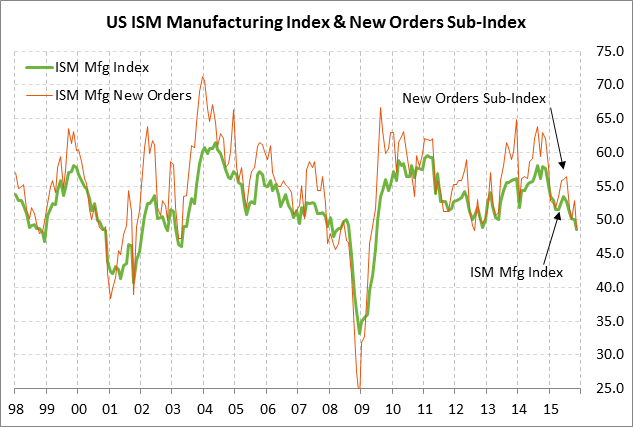- Weekly market focus
- This week’s U.S. economic schedule is expected to be mostly on the strong side
- U.S. ISM manufacturing index expected to show a small increase but remain below the boom-bust level of 50.0
- Will Iranian sanctions really be dropped in 2016?
- Q4 earnings growth is expected to be poor at -3.7%
-
Weekly market focus — The markets this week will focus on (1) crude oil prices, which have recently been a key driving factor for the world equity and bond markets, (2) Friday’s payroll report (expected +200,000) and whether it affects market expectations for the timing of the Fed’s next rate hike, (3) the Chinese Shanghai Composite stock index, which posted a 4-1/2 month high on Dec 23 but then fell back as tensions remain high about the Chinese economy, and (4) this Wednesday’s release of the Dec 15-16 FOMC meeting minutes, which may shed some additional light on the Fed’s decision to raise interest rates at that meeting.
This week’s U.S. economic schedule is expected to be mostly on the strong side — This week’s U.S. economic schedule is busy and is expected to be mostly on the stronger side. Strong reports this week are expected to include (1) today’s Dec ISM manufacturing index (expected +0.4 to 49.0), (2) Wednesday’s Dec ADP report (expected +194,000), (3) Wednesday’s Dec ISM non-manufacturing index (expected +0.1 to 56.0), and (4) Friday’s Dec unemployment report (payrolls expected +200,000 and the Dec unemployment rate is expected to be unchanged from Nov’s 8-year low of 5.0%).
Weak reports this week are expected to include (1) Tuesday’s Dec total vehicle sales report (expected 18.00 million vs Nov’s 18.05 million), and (2) Wednesday’s Nov factory orders report (expected -0.2% after Oct’s +1.5%). Wednesday’s Nov U.S. trade deficit report is expected to widen mildly to -$44.25 billion from -$43.89 billion in October.
U.S. ISM manufacturing index expected to show a small increase but remain below the boom-bust level of 50.0 — The markets are expecting today’s Dec ISM manufacturing index to show a small +0.4 point upward rebound to 49.0, recovering part of November’s -1.5 point decline to a 6-1/2 year low of 48.6. The ISM index in November fell below the expansion-contraction level of 50.0 for the first time in 3 years, illustrating the poor condition of the U.S. manufacturing sector.
The ISM manufacturing new orders sub-index is in a similarly weak condition, having fallen by -4.0 points in Nov to a 3-1/3 year low of 48.9. That indicates that manufacturing orders are contracting and that the manufacturing orders pipeline is sparse. Nov factory orders were down by -4.5% y/y overall and by -6.5% y/y ex-transportation, providing another indicator of the weak order flow into the manufacturing sector.
The U.S. manufacturing sector is in a recession due to the petroleum sector contraction combined with weakness in U.S. manufacturing exports caused by the strong dollar and weak overseas economic growth. The only positive factor for the U.S. manufacturing sector at present is the strong level of U.S. vehicle sales.
Will Iranian sanctions really be dropped in 2016? — The odds are that Iranian sanctions will in fact be dropped since Iran has so far met all its required progress milestones and the Obama administration does not want to give up its hard-fought battle to win an Iranian nuclear agreement. Still, there is the possibility that the process could derail in coming months since Iran has been making provocative moves that could cause the agreement to blow-up and since the U.S. is considering new sanctions. Specifically, Iran recently conducted ballistic missile tests that were clear violation of existing U.N. resolutions and there were reports last week that the U.S. was preparing new sanctions to address those missile violations. Iran could use the new sanctions to claim that the U.S. violated the nuclear agreement and to therefore declare the agreement void. Iran late last week also launched a rocket near a U.S. aircraft carrier in the Persian Gulf, which U.S. military officials called “highly provocative.”
The Iranian government is most likely just using the recent provocations as a signal to its hard-liners and the Iranian street that Iran is not rolling over for the U.S. with the nuclear agreement and that it will continue to challenge the West on all fronts. Moreover, the rules on Iranian ballistic missile tests under the nuclear agreement are much more lax than previous rules, meaning that the U.S. will have a harder time justifying new sanctions based on Iranian missile tests going forward.
Still, if the Iranian nuclear agreement were to break down, that would be a major bullish factor for oil prices and could produce a rally of at last $10 per barrel. The markets have already at least partially discounted the onslaught of new Iranian oil production and exports that is likely to start by mid-2016.
Q4 earnings growth is expected to be poor at -3.7% — Q4 earnings season begins next Monday (Jan 11) with Dow-component Alcoa scheduled to report. There are only four of the S&P 500 companies that report earnings this week. The markets are expecting another poor earnings quarter in Q4, meaning there is not likely to much of an upside catalyst for stock prices over the Q4 earnings season except that the bar for Q4 earnings is so low that it will not be hard to beat. The market consensus is for Q4 SPX earnings to decline by -3.7% y/y, worse than the -0.8% decline seen in Q3, according to Thomson I/B/E/S. However, the market is then looking for an improvement in earnings growth in 2016 with SPX earnings growth of +2.5% in Q1, +3.9% in Q2, and +8.4% in Q3. On an annual basis, the consensus is for earnings growth in 2016 to improve to +7.8% from unchanged in 2015.





